
[Source: criticsrant.com]
Evidence Suggests that First Lady Florence Harding Killed Her Husband, the 29th President Warren G. Harding, A Century Ago Today to Protect His Reputation and Legacy.
[This article follows CAM’s series on political assassinations.—Editors]
On the night of August 2, 1923, exactly one hundred years ago, President Warren G. Harding, 57, suddenly fell ill and died at the opulent Palace hotel in San Francisco.
In most history books, the cause of Harding’s death is listed as a heart attack. But significant contemporary testimony—including that of the heir of the man who owned the San Francisco hotel where Harding died, says Harding should be added to the list of presidents who have been assassinated while in office, and that he was actually murdered—with the primary suspect being his wife Florence.[1]
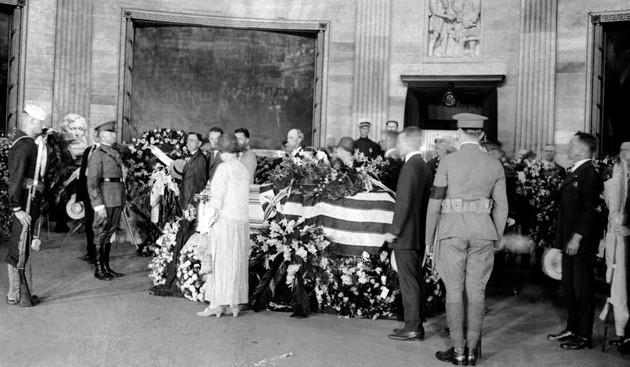
On the night Harding died, Florence was reading to her husband, who had been traveling on the West Coast after visiting Alaska.
When Warren suddenly stopped breathing, Florence screamed for doctors. After he was declared dead, the doctors kept switching the cause of death, first claiming that a blood vessel in Harding’s brain had burst, then saying he had died of a stroke, and then of a heart attack and gall bladder condition.
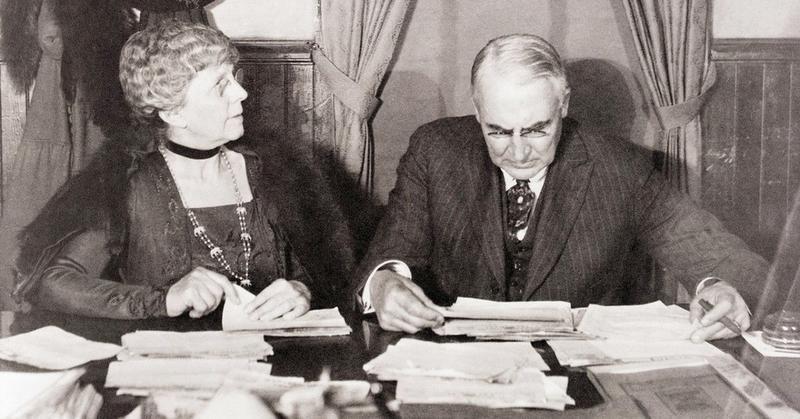
Florence ordered that no autopsy be performed and that Warren’s body be embalmed immediately.[2]
Shortly before he died, Harding had been asking Commerce Secretary Herbert Hoover’s advice on publicly exposing “a great scandal in our administration.”[3] Hoover said that when he walked into Harding’s room, his doctor, Charles Sawyer was oddly lying on the bed next to his dead body.[4]
When Janet Johnston, the granddaughter of the Palace Hotel’s founder, U.S. Senator William Sharon (R-NV) entered the Hardings’ room and saw that Warren was dead, Florence flew into a rage, claiming that the hotel’s food had killed her husband and that she was going to sue.
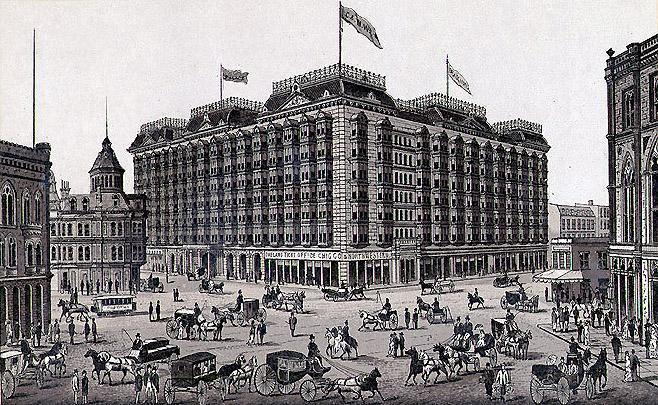
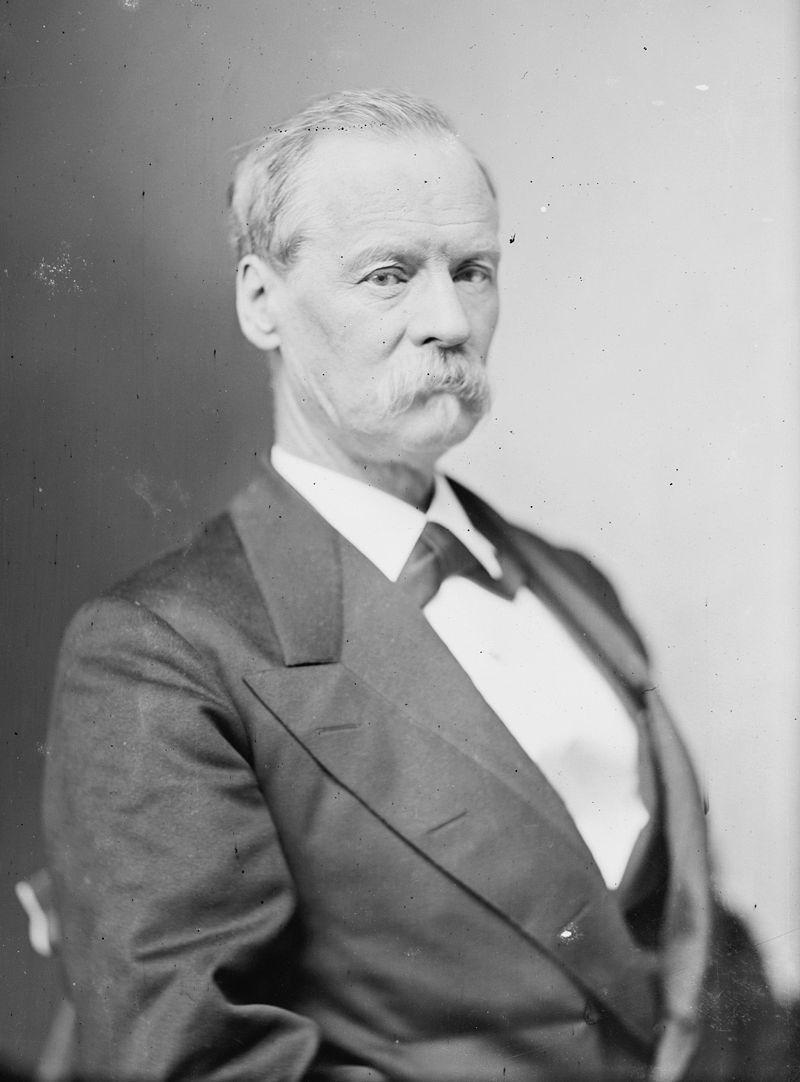
Janet, however, told Florence that the claim was ludicrous as no one else staying at the hotel suffered from any food-borne illnesses.
When Janet picked up a half-filled glass near President Harding’s bed, she found that it had a noxious odor and suspected that whatever was in the glass had something to do with his death.
Janet told Florence that she intended to have the contents of the glass analyzed, at which point Florence snatched the glass away and managed to pour whatever was in it down the drain. She then turned to Janet and said “there will be no lawsuit.””[5]
The Duchess and “her Warren”
Florence was among the more popular First Ladies whose words were quoted in newspapers and magazines and whose image was displayed in newsreels.
A feminist who supported suffrage and championed the interests of the nation’s World War I veterans, Florence had opened the White House to visitors and encouraged women to exercise, play sports and be as physically fit as men.[6] At the same time, she wrote and corrected her husband’s speeches and weighed in on his choices for important Cabinet posts.[7]
Florence’s behavior on the night of her husband’s death was not out of character as she had a domineering nature and was fiercely loyal to “her Warren,” who called her “the Duchess.”
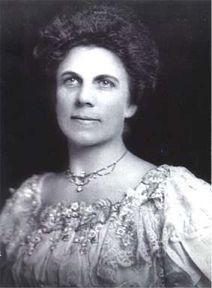
Daughter of Arthur Kling, the wealthiest citizen of Marion, Ohio, Florence had married Harding, five years her junior, in 1891 when she was a divorcee with a son whom she had abandoned.[8]
Gaston Means, a private investigator hired by Florence to look into her husband’s extramarital trysts, described Florience as a “woman of brains: cold, logical [and calculating]” with a “consuming thirst for power.” For years she was the financial head of the Harding household since Warren was a “child in business matters.”
Possessing beautiful blue eyes and a delicate body with unusually large hands, Florence had worked tirelessly behind the scenes to place her husband “in the highest position in…the greatest nation of the world.”
She was “familiar with everything pertaining to governmental affairs to the last detail,” Means wrote. This included “every phase of state and diplomatic strategy.” As First Lady, Florence “continue[d] to be the central moving factor [in her husband’s political career]: the determining factor.”[9]
What Kind of President Was Warren G. Harding?
A newspaper publisher from Marion, Ohio, Harding defeated his Democratic Party challenger, James Cox, in the 1920 presidential election, campaigning on a slogan of a “return to normalcy” after the tumult of World War I and the first Red Scare.
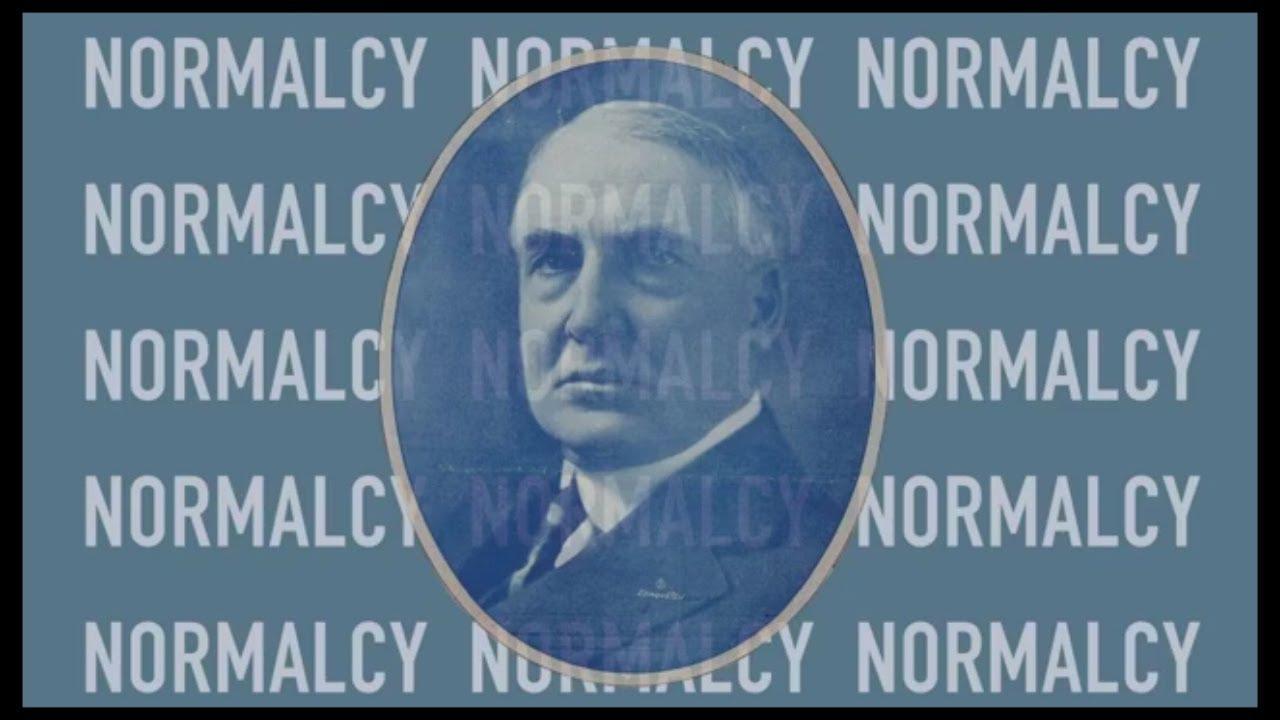
During a five year career in the U.S. Senate Harding introduced 134 bills of which 122 were local Ohio affairs, with the other 12 focusing on mundane matters like promoting celebration of the landing of the Pilgrims. The New York Times considered Harding to be the “firm and perfect flower of the cowardice and imbecility of the Senatorial cabal.”[10]
As President, Harding reduced the federal debt and released political prisoners like Socialist Party leader Eugene V. Debs, who had been jailed for opposing U.S. entry into the Great War.
He also proposed a reduction in military spending, withdrew U.S. troops from Cuba and the Dominican Republic, and oversaw the Washington Naval Conference of 1921-1922 in which the world’s major powers agreed on a naval limitation program—albeit one that maintained strategic advantage for the U.S. and England vis-à-vis Japan, which expanded its program of militarization and regional colonization in response.[11]
In 1923, Massachusetts Senator Henry Cabot Lodge confided to a friend that “Harding is very satisfactory to the financial interests.”[12] His Attorney General, Harry Daugherty, “quashed prosecution of war profiteers and other spoilsmen of Wall Street and waged vigorous warfare against labor organizations” while the Commerce Department, under the direction of Herbert Hoover, was transformed into a “marketing agency for the big industries.”[13]
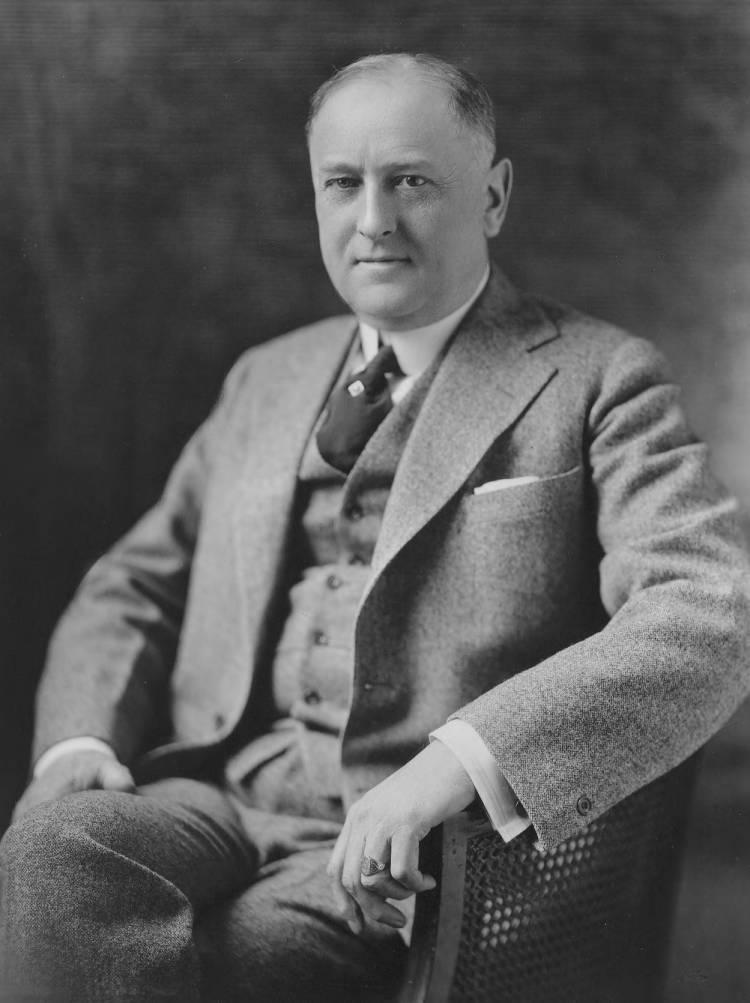

Harding’s white supremacist outlook was apparent in his praise for Lothrop Stoddard, whose book The Rising Tide of Color Against White World-Supremacy (1920) warned about the destruction of white society by invading non-white hordes.
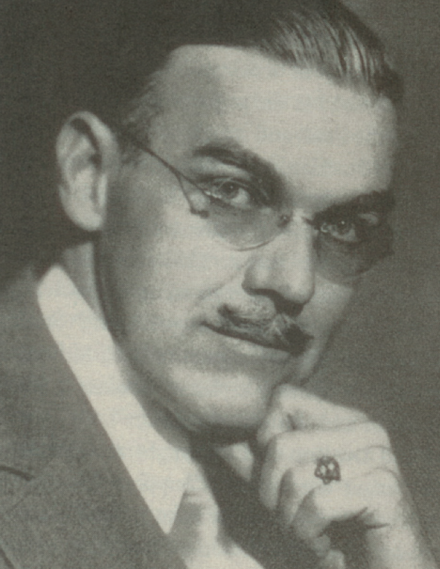
As a precursor to modern day conservatives, Harding supported a harsh anti-immigrant bill mandating deportations and drastic income tax cuts (the top marginal rate was reduced from 75% in 1921 to 25% in 1925) based on the argument of Treasury Secretary Andrew Mellon[14] that lower rates would increase tax revenues because, when income taxes were high, money was driven underground or abroad.
Libertarian historians credit these cuts with ushering in a dramatic period of economic growth, though many other historians blame Mellon’s economic approach for the sweeping inequality and economic volatility that produced the Great Crash of 1929 and the Depression.[15]
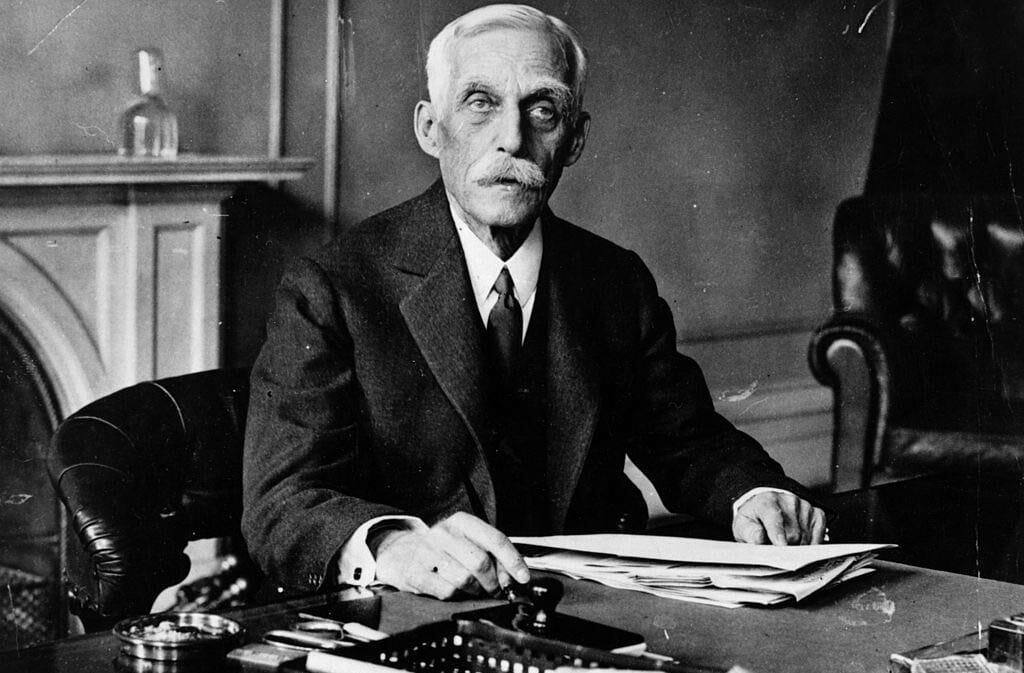
An Administration Scarred with Shame and Corruption
When Arthur M. Schlesinger, Sr. polled historians to measure presidents’ standing in 1948 and 1962, Harding ranked dead last. Schlesinger concluded that Harding and Ulysses S. Grant were “morally obtuse” and conducted administrations “scarred with shame and corruption.”[16]
According to historian Ferdinand Lundberg, Harding was a product of Mark Hanna’s Standard Oil machine in Ohio and his administration was “soaked in petroleum.”[17]
The Ohio gang was a collection of powerful political figures and industrialists mainly from Ohio who held sway over Harding and pushed him to sign legislation that benefited the petroleum industry and made them rich.[18] They were involved in an array of criminal schemes, including arranging for the sale of permits to people who wanted to withdraw liquor from bonded government warehouses and worked out illegal sales of government property.[19]

A popular saying held that “everything was for sale in Washington during the Harding administration—except the dome of the Capitol.”[20]
Just three months after his inauguration, Harding issued an executive order transferring the Navy’s oil reserves from the Navy to the Department of the Interior so they could be acquired by private companies.
The Ohio gang derived enormous profits from buying up oil company stocks. Hundreds of thousands of dollars derived from illicit financial dealings and graft were stored in secret vaults, as members of the gang “had daily banquets of the finest food and finest wines.”[21]
The corruption in Harding’s administration was exemplified by the Teapot Dome scandal in which a Senate investigation led by Senators Thomas J. Walsh (D-MT) and Burton K. Wheeler (D-MT) uncovered that Secretary of the Interior Albert B. Fall had leased Navy petroleum reserves at Teapot Dome in Wyoming, as well as two locations in California, to private oil companies—Sinclair and Pan American Petroleum and Transport—at low rates without competitive bidding after taking $404,000 in bribes.[22]
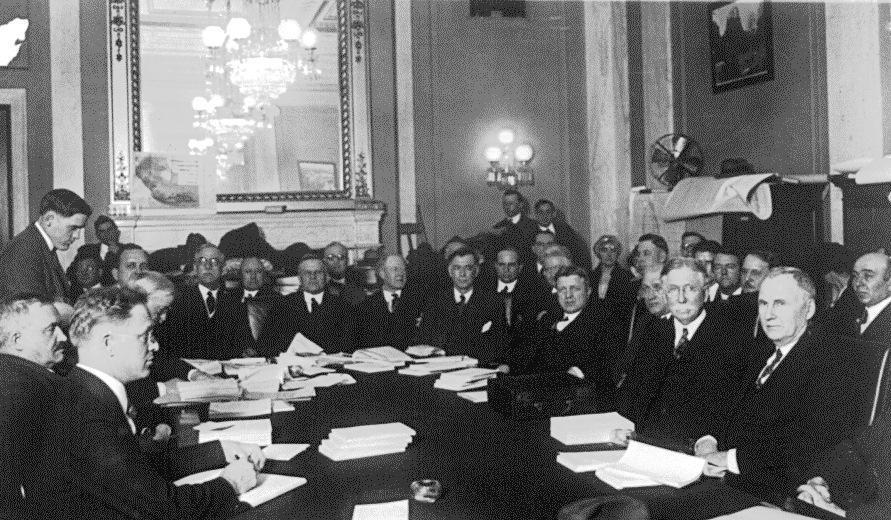


Government investigators and people linked to the scandal died suddenly before they were slated to testify. Harry Daugherty’s gopher, Jess Smith, was said to have shot himself with a pistol in Washington’s Wardman Hotel; however, nobody heard the shot, and Smith never fired a pistol in his life—he was mortally afraid to ever hold one.[23]
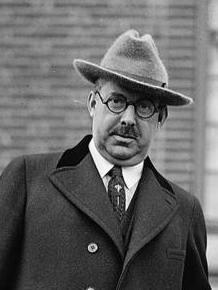
Senator James Thomas Heflin said: “nobody knew what he [Smith] knew, and with him dead there was nobody to tell the story—so Jess Smith was murdered.”[24]
Who Tipped Off The Wall Street Journal Publisher?
Clarence Walker Barron, publisher of the Wall Street Journal, seems to have had foreknowledge of Harding’s death–which would seem to corroborate that he had been poisoned.
During a bridge game at his home the night Harding died, Barron had his secretary phone his office until news came across the wire that Harding had a stomach ache from eating crab.
Barron then exclaimed: “That’s it! get me the vice-president [Calvin Coolidge]”–who was spending the evening with his father and one of Barron’s good friends.[25]
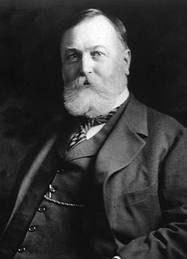
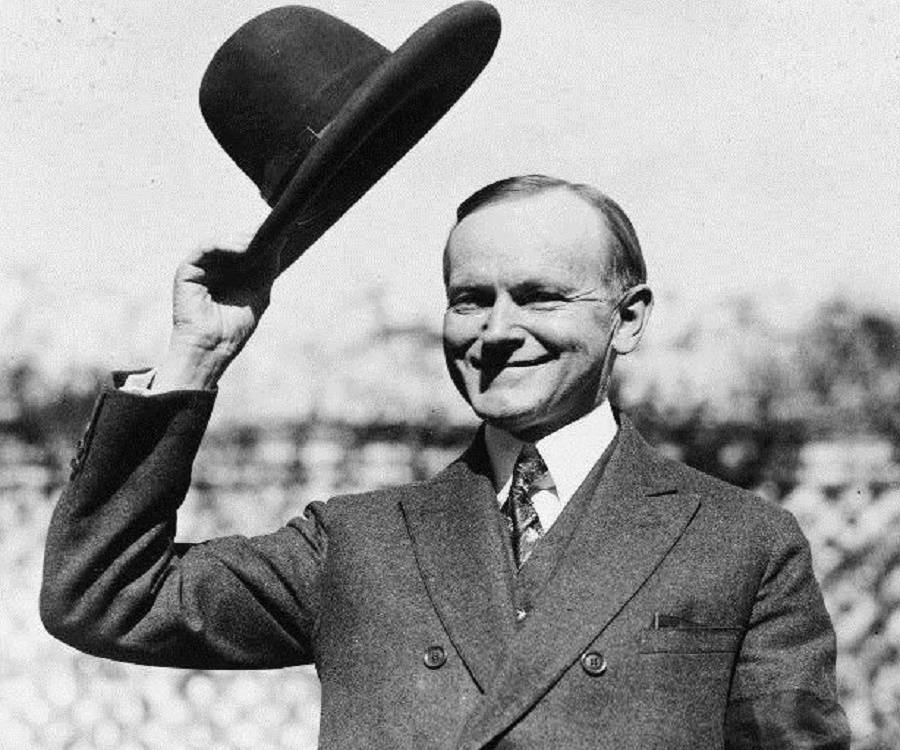
Revelations of Gaston Means
Gaston Means was hired by Mrs. Harding to investigate Warren’s affair with a young woman named Nan Britton who alleged that Harding fathered her child—a claim that was validated by correspondence found 40 years after Harding’s death and recent DNA testing.[26]
In 1930, with the assistance of a ghostwriter, May Dixon Thacker, Means published a book, The Strange Death of President Harding (New York: Guild Publishing Corporation, 1930), which suggested that Mrs. Harding had killed her husband to prevent his impeachment and protect his legacy, which would have been tarnished by revelations about his philandering and the deep corruption in his administration which was in the process of being exposed.[27]
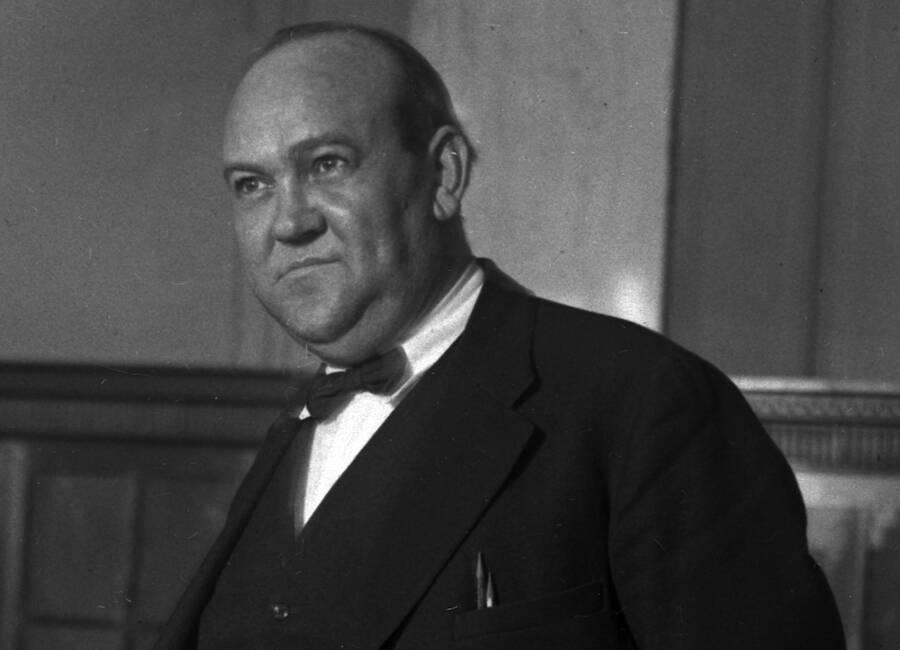
A secondary motive for Mrs. Harding was revenge, as she was heartbroken by Means’s uncovering details of her husband’s affair with Ms. Britton.
Born into a wealthy family near Concord, North Carolina, in 1879, Means joined the William Burns Detective Agency in 1914. Described by PBS as “an embittered former Harding administration official and bootlegger,” Means had previously worked for the Mexican, U.S. and British governments, J.P. Morgan, and Henry Clay Frick, and said that he had “come in contact with the greatest political and commercial leaders in our land.”[28]
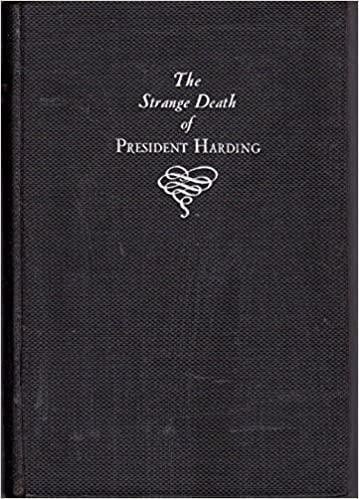
Means had met Thacker while he was imprisoned in the Atlanta penitentiary. She agreed to tell his story, which she said was “in no way a reflection on the American political system [but rather] a vindication of it. It clearly reveals how a Great Party was tricked and how it has extricated itself with dignity and poise and surety of purpose unexcelled in history.”[29]
Means purported to want to reveal in his book not only Mrs. Harding’s role in her husband’s murder, but “the tragic web-mystery of the entire Harding administration,” which had been “garbled and distorted and buried beneath an avalanche of untruths and misrepresentations.”
The administration’s true history was in actuality a “scarlet thread” that “entangled politicians, bankers, capitalists, industrialists, [and] worthwhile world and underworld characters.” It was part of a period of “high ambitions, dazzling lights and impenetrable blackness—of trusts dishonored and basest treacheries—of amazing contrasts and blatant conspiracies and hidden murder.”[30]
Means wrote that he was the “only living human being who held accurate knowledge of dangerous truths concerning social, political, financial and international secrets of President Harding and his Ohio gang associates.”
The others who knew of the secrets—he listed: C.F. Cramer, Jess Smith, a Boston lawyer Thurston, John T. King, C.F. Hately, Warren G. Harding, Mrs. Florence Kling Harding, General Sawyer, and Colonel Thomas B. Felder—all supposedly committed suicide or died suddenly.
Colonel Felder was said to have died from alcohol poisoning though no autopsy was performed. He had been a close friend of Harry Daugherty and Jess Smith, and was traveling to Atlanta to provide Means with key incriminating documents about them when he died.
Means said that, had Felder lived, he was “prepared and was just about to reveal to the world the multiple scandals during the era referred to by John W. Davis, the 1924 Democratic Party candidate for the presidency, in his speech of acceptance, as “those melancholy years.”[31]
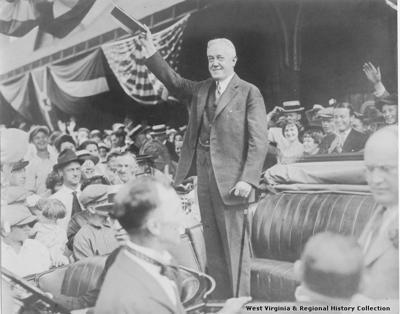
The way Means depicted it, Harding was good looking, but easily manipulatable, and “always blind to the faults of his friends—everyone knows that.”
In 1893, Harding had first met Daugherty, a lobbyist and two-term state representative who made him run for lieutenant governor of Ohio and backed his political career. Daugherty was fond of saying that Harding “looks like a president and has the regal look of a king.”[32]
When Florence hired Means to look into her husband’s affair with Nan Britton—a pretty blond 30 years younger than Warren—he uncovered that the affair had begun when Warren was still working for the Marion Daily Star, and Britton was only fourteen or fifteen. She would come into the newspaper offices and sit on Harding’s lap and he would fondle her breasts.
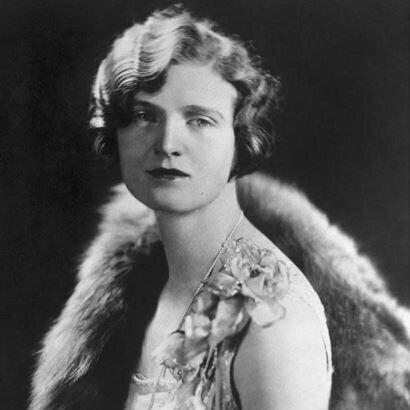
When Florence confronted Harding with her knowledge of Ms. Britton, Warren said to his wife dramatically: “You have ruined me, you have ruined me and your contemptible detective [Mr. Means].”[33]
Florence subsequently asked Warren what he would do with her now and Warren said “you can do what you damn please.” Florence replied: “Warren=Warren—think of our young love,” to which Warren responded, “in truth, I never loved you. You ran me down.”
Facing impeachment, Harding’s health began to suffer afterwards; Florence said he “lost his jovial, confident demeanor and was looking and acting more and more like a hounded animal.”[34]
Means said that, contrary to reports of a heart attack or stroke, Warren’s death in San Francisco’s Palace Hotel was from ptomaine poisoning.
Tellingly, the newspapers noted “how wonderfully well Mrs. Harding was bearing up under the tremendous shock [of her husband’s death].”[35]
Means had grown very close to Florence who told him the whole story of her involvement.
She said that she had been alone with Warren before his death and that after he drank the poison, he lay back and rested, and then suddenly opened his eyes and looked into her face, before nodding off for eternity.
Means allegedly asked: “Do you think he knew?” to which Florence replied: “Yes.”[36]
Afterwards, Florence prevented an autopsy by guarding Warren’s body and claiming that she did not want it cut up.
Florence told Means that, by killing her husband, she had fulfilled her destiny and had no regrets.
That destiny was as the guardian and protector of her husband’s career—till death do us part.
Postscript: For weeks after Warren’s death, smoke could be seen rising from the White House chimney as Florence burned her now deceased president’s papers in order to protect him—a task that she continued after she returned to live on a farm in Marion, Ohio.[37]
A year later, Florence died—like her husband under suspicious circumstances. Perhaps she too was a victim of the machinations of the Ohio gang, which either sought revenge on her or wanted to ensure that the truth of her husband’s death never got out.

-
Thomas Peele, “San Francisco Hotelier’s Heir Says Harding Was Assassinated,” Marin Independent Journal, September 3, 2018, https://www.marinij.com/2018/09/03/san-francisco-hoteliers-heir-says-harding-was-assassinated/. ↑
-
Peele, “San Francisco Hotelier’s Heir Says Harding Was Assassinated.” Florence even prevented a death mask from being made. ↑
-
Richard Bartholomew, The Deep State in the Heart of Texas, with foreword by Edward Tatro (San Antonio: Say Something Real Press, 2018), 181. Hoover advised disclosure, but Harding died before taking his advice. ↑
-
Donald Jeffries, Crimes and Cover Ups in American Politics, 1776-1963: The History They Didn’t Teach You in School (New York: Skyhorse Publishing, 2019)., 202. ↑
-
Peele, “San Francisco Hotelier’s Heir Says Harding Was Assassinated.” An alternative theory holds that Ms. Harding was covering up for the negligence of Warren’s doctor, Charles E. Sawyer, who provided Harding with too many purgatives, aggravating his heart condition and pushing him into cardiac arrest. Others have suggested that Harding was poisoned by Attorney General Harry Daugherty and other members of the Ohio gang “to save him from embarrassment of political scandals.” Carl Sferrazza Anthony, Florence Harding: The First Lady, the Jazz Age, and the Death of America’s Most Scandalous President (New York: William Morrow & Company, Inc., 1998), 460, 472. ↑
-
Anthony, Florence Harding, xi, xii. ↑
-
Katherine A. Sibley, First Lady Florence Harding: Behind the Tragedy and Controversy (Lawrence: University Press of Kansas, 2009), 1. ↑
-
Eugene P. Trani and David L. Wilson, The Presidency of Warren G. Harding (Lawrence: University Press of Kansas, 1977), 33; Charles L. Mee Jr., The Ohio Gang: The World of Warren G. Harding (New York: M. Evans and Company, Inc., 1981), 55, 56.; Anthony, Florence Harding, xvi. Florence’s father had socialized her as his first male child, teaching her business and finance. Before she met Warren, she supported herself as a piano teacher. Kling did not support Florence’s marriage to Warren initially, believing that he had “negro” blood in him. ↑
-
Gaston B. Means, as told to May Dixon Thacker, The Strange Death of President Harding (New York: Guild Publishing Corporation, 1930), 55; Mee Jr. The Ohio Gang, 55; Anthony, Florence Harding, xvii, 56. Florence had served as the business manager of The Marion Star and made it a financial success. She bragged openly that she had made her husband president. One Marionite wrote that “Florence Harding runs her house, runs the paper…runs Warren; runs everything but the car, and could run that if she wanted to.” ↑
-
Francis Russell, The Shadow of Blooming Grove: Warren G. Harding in His Times (New York: McGRaw-Hill, 1968), 259, 470. ↑
-
Trani and Wilson, The Presidency of Warren G. Harding; Robert H. Ferrell, The Strange Death of President Harding (Columbia: University of Missouri Press, 1996) which adheres to the official view of Harding’s death and promotes a positive view of Harding’s presidency. From his time as a newspaper publisher, Harding had supported “the emergence of the United States on the world scene,” and opposed Woodrow Wilson’s policy of granting independence to the Philippines. On the Washington Conference, see Thomas H. Buckley, The United States and the Washington Conference, 1921-1922 (Knoxville, TN: University of Tennessee Press, 1970). The Washington Treaty established a 10:7 naval advantage for the U.S. over Japan. ↑
-
Ferdinand Lundberg, America’s 60 Families (New York: Vanguard Press, 1937), 151. ↑
-
Lundberg, America’s 60 Families, 162. According to historian Francis Russell, Daugherty viewed the world through the vermillion-tainted glasses of his radical-riding predecessor A. Mitchell Palmer, believing that strikers were controlled and manipulated by “Red Agents of the Soviet government” under the direction of Lenin’s associate, Grigori Zinoviev. Russell, The Shadow of Blooming Grove, 546. ↑
-
From Pittsburgh, Mellon was a banker to the Robber Barons who was one of the five richest Americans in the United States. Besides income tax cuts, he pushed for the highest tariff rate in American history (Fordney-McCumber Act of 1922) to protect American industry and cuts to social spending, which helped reduce the national debt to two thirds of its former level. ↑
-
See John Kenneth Galbraith’s classic, The Great Crash, 1929 (New York: Pelican, 1961). ↑
-
Trani and Wilson, The Presidency of Warren G. Harding, 189; Arthur M. Schlesinger, Sr., “Our Presidents; A Rating By 75 Historians,” The New York Times, July 29, 1962, https://www.nytimes.com/1962/07/29/archives/our-presidents-a-rating-by-75-historians-a-poll-of-exports.html. Robert H. Ferell in The Strange Death of President Harding promotes a more positive view, noting that Harding was tall and good looking and looked presidential; that he reduced the federal debt, and that he was popular in his time, as was evident in the massive crowds that came out to greet his funeral procession. According to Ferrell, the shock of Harding’s death was nearly as great as that after the assassination of Abraham Lincoln. ↑
-
Lundberg, America’s 60 Families, 158, 159. ↑
-
Mee, Jr., The Ohio Gang. ↑
-
Trani and Wilson, The Presidency of Warren G. Harding, 180. One bootlegger claimed to have paid Ohio gang member Jess Smith, who worked for Attorney General Harry Daugherty, more than $250,000 for immunity, while another group paid as high as $20,000 for a permit to withdraw liquor from a bonded warehouse. ↑
-
Harding admitted to his own incompetence, stating, “I am not fit for this office and should never have been here.” In Trani and Wilson, The Presidency of Warren G. Harding, 172. ↑
-
Gaston B. Means, as told to May Dixon Thacker, The Strange Death of President Harding (New York: Guild Publishing Corporation, 1930), 196. ↑
-
Laton McCartney, The Teapot Dome Scandal: How Big Oil Bought the Harding White House and Tried to Steal the Country (New York: Random House, 2009); Burl Noggle, Teapot Dome: Oil and Politics in the 1920s (New York: W.W. Norton, 1965). Percy Rockefeller and Prescott Bush were tied to the scandal though never indicted. ↑
-
Means, The Strange Death of President Harding, 226. On February 16, 1929, Edward Doheny, Jr., and his friend Hugh Plunkett were found together in Doheny’s lavish estate in Beverly Hills, both shot in the head. ↑
-
In Jeffries, Crimes and Cover Ups in American Politics, 1776-1963., 203. ↑
-
Bartholomew, The Deep State in the Heart of Texas, 181. ↑
-
Trani and Wilson, The Presidency of Warren G. Harding, 178; Jeffries, Crimes and Cover-ups in American Politics, 1776-1963, 203. ↑
-
Means, The Strange Death of President Harding. Means has been smeared in the media in an attempt to discredit him like many other whistleblowers and portrayed as a would be hit man in the television series Boardwalk Empire. Historian Francis Russell called him a “psychotic swindler.” The Shadow of Blooming Green, xv. Leading journalists of the 1930s such as Frederick Lewis Allen, the editor of Harper’s Magazine who wrote a popular history of the 1920s, and The Nation editor Oswald Garrison Villard, believed that there was foul play in Harding’s death. ↑
-
Means, The Strange Death of President Harding, 22. Means died in Leavenworth Prison in 1938 after being convicted for a con he allegedly tried to pull related to the Charles Lindbergh kidnapping. ↑
-
Means, The Strange Death of President Harding, preface. ↑
-
Means, The Strange Death of President Harding, 25. ↑
-
Means, The Strange Death of President Harding, 16. Felder died in Savannah, Georgia. ↑
-
Means, The Strange Death of President Harding, 49. ↑
-
Means, The Strange Death of President Harding. According to Means, Harding at that point threatened him, telling him he would be placed under surveillance and indicted which he eventually was. ↑
-
Means, The Strange Death of President Harding, 260. ↑
-
Other reports described Florence as being very stoic during her husband’s funeral. ↑
-
Means, The Strange Death of President Harding, 263. ↑
-
Mee Jr. The Ohio Gang, 234, 235; Anthony, Florence Harding, 489. According to Anthony, when back in Marion, Florence went every morning for a six week period down to Warren’s old private Star office where she had crates of his papers “placed and the old pot-bellied stove fired up as she continued her burning.” ↑
CovertAction Magazine is made possible by subscriptions, orders and donations from readers like you.
Blow the Whistle on U.S. Imperialism
Click the whistle and donate
When you donate to CovertAction Magazine, you are supporting investigative journalism. Your contributions go directly to supporting the development, production, editing, and dissemination of the Magazine.
CovertAction Magazine does not receive corporate or government sponsorship. Yet, we hold a steadfast commitment to providing compensation for writers, editorial and technical support. Your support helps facilitate this compensation as well as increase the caliber of this work.
Please make a donation by clicking on the donate logo above and enter the amount and your credit or debit card information.
CovertAction Institute, Inc. (CAI) is a 501(c)(3) non-profit organization and your gift is tax-deductible for federal income purposes. CAI’s tax-exempt ID number is 87-2461683.
We sincerely thank you for your support.
Disclaimer: The contents of this article are the sole responsibility of the author(s). CovertAction Institute, Inc. (CAI), including its Board of Directors (BD), Editorial Board (EB), Advisory Board (AB), staff, volunteers and its projects (including CovertAction Magazine) are not responsible for any inaccurate or incorrect statement in this article. This article also does not necessarily represent the views the BD, the EB, the AB, staff, volunteers, or any members of its projects.
Differing viewpoints: CAM publishes articles with differing viewpoints in an effort to nurture vibrant debate and thoughtful critical analysis. Feel free to comment on the articles in the comment section and/or send your letters to the Editors, which we will publish in the Letters column.
Copyrighted Material: This web site may contain copyrighted material the use of which has not always been specifically authorized by the copyright owner. As a not-for-profit charitable organization incorporated in the State of New York, we are making such material available in an effort to advance the understanding of humanity’s problems and hopefully to help find solutions for those problems. We believe this constitutes a ‘fair use’ of any such copyrighted material as provided for in section 107 of the US Copyright Law. You can read more about ‘fair use’ and US Copyright Law at the Legal Information Institute of Cornell Law School.
Republishing: CovertAction Magazine (CAM) grants permission to cross-post CAM articles on not-for-profit community internet sites as long as the source is acknowledged together with a hyperlink to the original CovertAction Magazine article. Also, kindly let us know at info@CovertActionMagazine.com. For publication of CAM articles in print or other forms including commercial internet sites, contact: info@CovertActionMagazine.com.
By using this site, you agree to these terms above.
About the Author

Jeremy Kuzmarov holds a Ph.D. in American history from Brandeis University and has taught at numerous colleges across the United States. He is regularly sought out as an expert on U.S. history and politics for radio and TV programs and co-hosts a radio show on New York Public Radio and on Progressive Radio News Network called “Uncontrolled Opposition.”
He is Managing Editor of CovertAction Magazine and is the author of six books on U.S. foreign policy, including Obama’s Unending Wars (Clarity Press, 2019), The Russians Are Coming, Again, with John Marciano (Monthly Review Press, 2018), Warmonger. How Clinton’s Malign Foreign Policy Launched the U.S. Trajectory From Bush II to Biden (Clarity Press, 2023); and with Dan Kovalik, Syria: Anatomy of Regime Change (Baraka Books, 2025).
Besides these books, Kuzmarov has published hundreds of articles and contributed to numerous edited volumes, including one in the prestigious Oxford History of Counterinsurgency .
He can be reached at jkuzmarov2@gmail.com and found on substack here.

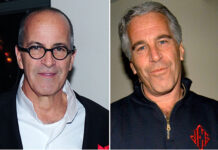
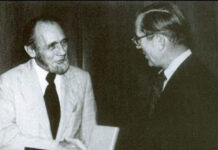
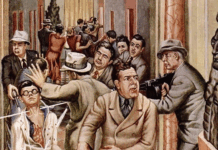

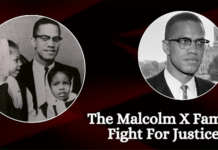
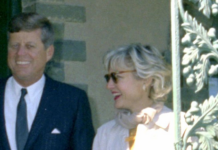
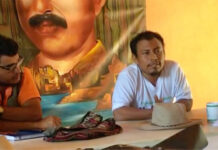

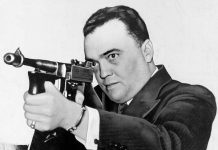

Fascinating narrative! Never knew any of this.
[…] In most history books, the cause of Harding’s death is listed as a heart attack. But significant contemporary testimony—including that of the heir of the man who owned the San Francisco hotel where Harding died, says Harding should be added to the list of presidents who have been assassinated while in office, and that he was actually murdered—with the primary suspect being his wife Florence.[1] […]
Nowadays feminists are working hard to challenge authoritarian governments around the world:
https://www.aspeninstitute.org/blog-posts/how-the-feminist-movement-is-challenging-authoritarianism/